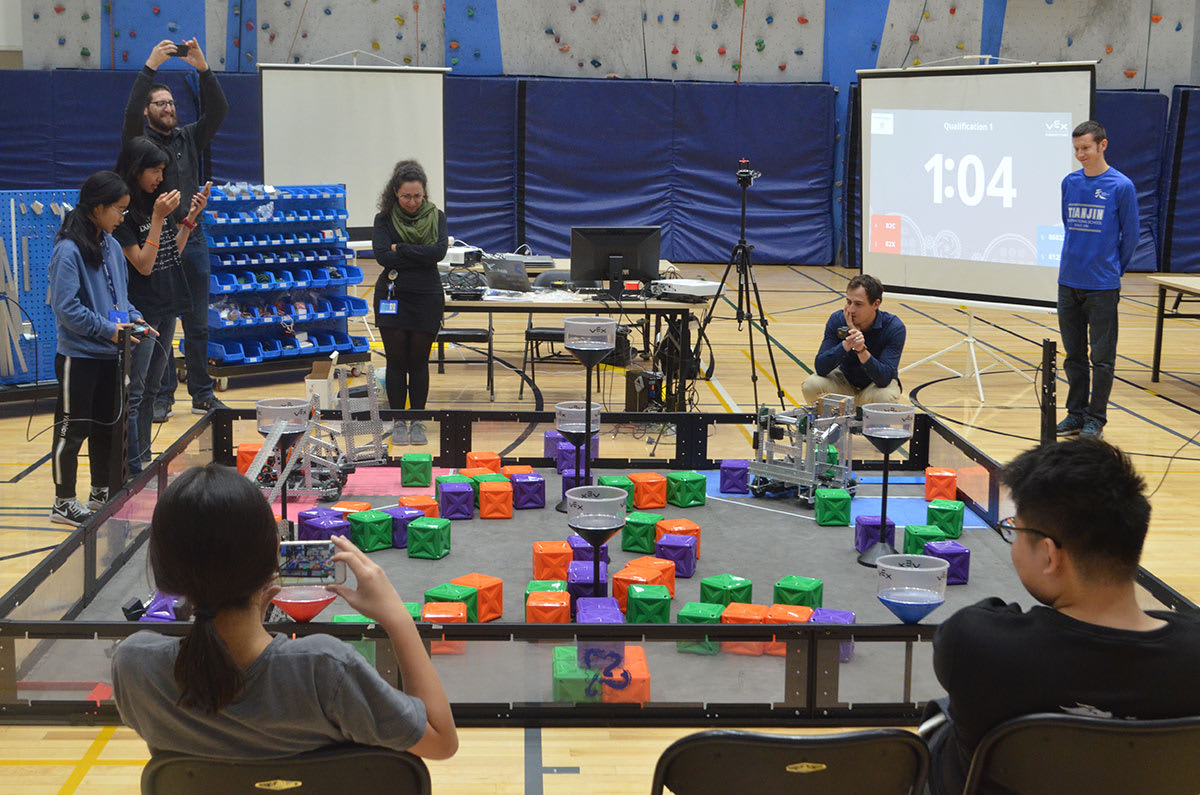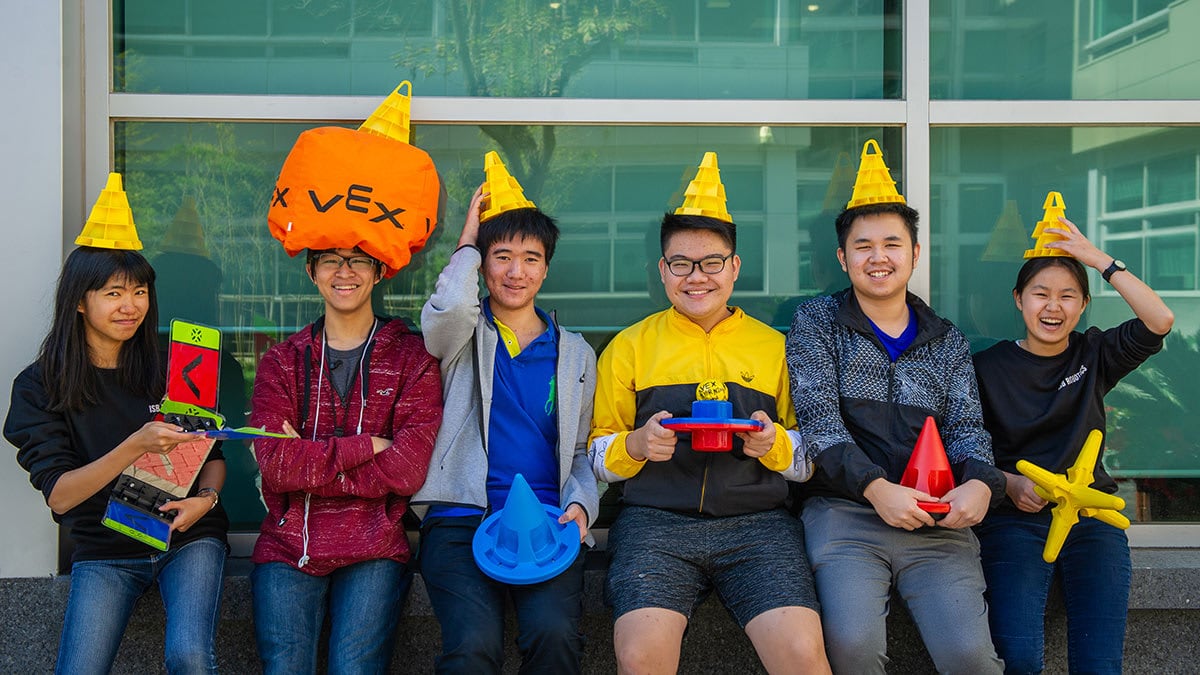Get Ready to Wage War with the Best Robot Combat Games!
By Nick Yates, ISB Communications
Anyone who’s seen Britain’s Robot Wars, America’s BattleBots, or China’s King of Bots TV shows will know how thrilling and satisfying robot competitions can be. The mechanized action came to the International School of Beijing (ISB) on Saturday, when ISB hosted its first Robotics Tech Challenge.
Students from schools around the region were tasked with designing their own bots to compete in challenges. The young engineers had to use creativity, technique, and teamwork as they worked in groups from weeks in advance of the big day to build machines capable of collecting and stacking treasure. The event was a great example of ISB’s commitment to challenging and joyful learning with the freedom to explore, and of the school being an inspiring international community based on strong relationships. It was held in preparation for students to enter one of over 1,000 Vex Robotics Competitions held annually worldwide.

Saturday’s robot showdown in Shunyi is the latest sign of rapid development in ISB’s tech and design programs. The school has been fine-tuning its curriculum and supercharging its co-curricular clubs to best prepare students for a world in which artificial intelligence is a bigger and bigger part of life and employment. Faculty are ensuring that graduates leave ISB with design, coding, and engineering skills.
An expanded set of High School course offerings for 2019-2020 includes Product Design; Graphic Design; Intro to Programming; 3D Modeling and Mechanics; Robotics: Control Systems Design; Game Design; and Robotics for Competitions.
These subjects are taught in balance with traditional academic disciplines and the emphasis is on interdisciplinary learning. Set to be completed in 2020, the new High School/Middle School Design Center is a centralized facility that will facilitate large-scale design and robotics courses while allowing for these disciplines to be more deeply applied in science, math, and art.
High School teacher Tyler Beatty was recruited by ISB last year to add more engineering into the integrated science curriculum and to build capacity for robotics and computer science in the course offerings. He led the initiative to start a robot competition at ISB.
“Robotics as a field of study plays an important role as the intersection between physical science, technical design, and programming,” Mr. Beatty said. “Competitions like VEX or the Middle School Robotics Challenge using Lego provide students with the opportunity to plan, design, build, test and present their solutions to judges. Through this, they gain skills in applying their science, math, and computational thinking practices, and they develop important habits of mind such as thinking ahead, creativity, and resilience.”

Here’s how three team captains of ISB’s participants in the Robotics Tech Challenge found their experience:
Aiki DP, Grade 12 (pictured, second from left)
Aiki joined the High School Robotics Club last academic year. He explained how his team employed a sophisticated design: “I didn’t want to go with the ideas that other people were using; I went for a tougher challenge. The linear cascaders we used were harder to make, but once you get the hang of the process, they’re very effective.”
Aiki said he was attracted to robotics because “I like to think through things a lot.” This hands-on subject that involves building, programming, geometry, and physics was perfect for him.
Vanessa Q, Grade 12 (pictured, far left)
“Of course, building skills were involved – how to put things together and use tools. The robot needs code to run, so you need to learn programming,” said Vanessa. “But more importantly, what I learned is all about designing something to complete a certain challenge, how to go through prototyping and figuring out what’s wrong and fixing it.”
Most projects at ISB, including the Robotics Tech Challenge, are based on the school’s Design Cycle referred to by Vanessa. Students work through steps beginning with identifying and understanding a problem before generating a range of divergent potential solutions. It’s only then that they move onto planning, testing, and refining stereotypes, before finally presenting design concepts to the community in addition to identifying further steps.
Vanessa, a two-year veteran of school robotics tournaments, also noted how important collaboration was in the Robotics Tech Challenge, which her team attacked with a design involving a base movable in four directions and an arm that could pick up its target objects. She divided her team of different grade levels so that they had distinct roles.
Arthur W, Grade 12 (pictured, third from left)
Arthur’s team’s robot involved a tower that stores all the cubes with a mechanism to “suck” the cubes into the tower. Arthur explained that they faced problems around how to best use the limited number of motors they were allowed. They poured hours into one design only to have to start over when it proved inefficient.
“You can make a longer-term investment in robotics” was Arthur’s answer when asked how robotics differs from traditional school subjects. “This club is very challenge-based. Every year, you are given a new game and a new set of rules; a new set of challenges with a new set of tools to solve those challenges.”
ISB is an extraordinary school, made so by a tradition of educational excellence spanning 45 years. Establishing, nurturing, and growing such an exceptional learning community has been and remains intentional; we work hard to build strong relationships so our learning is at its best.
